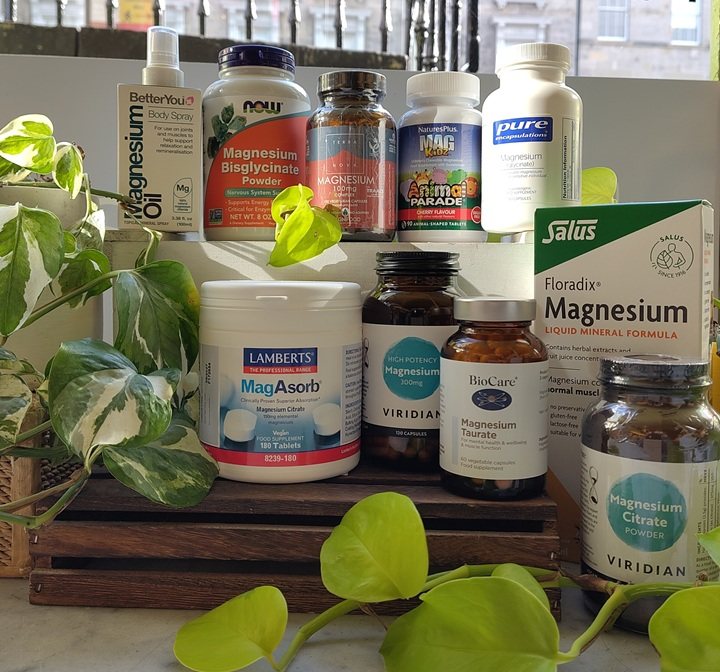What You Need To Know About… Magnesium
Magnesium is the most asked-for mineral in our store, more than Calcium, Iron, and Zinc put together. This is a ‘good thing’ and something that the store has been working towards for at least 35 years. When I started at Hanover Healthfoods enough was known about the importance of Magnesium that we no longer stocked Calcium on its own, only in combination with Magnesium, so we have a longer heritage than most in promoting the ‘Queen of Minerals’.
Magnesium is extremely important in the body, taking part in, or facilitating, hundreds of processes. Extensive government surveys of micro-nutrient consumption show that only about 20% of us get the full RDA of 400mg. These surveys are now about 20-30 years old now and I wouldn’t be surprised if that figure has climbed a little with increased awareness, both about food sources and the need for supplementation.
What Does Magnesium Do?
A lot of the properties of Magnesium come from the fact that it is the Yin to Calcium’s Yang.
The normal daily ratio of consumption of the two should be about 800mg of Calcium to 400mg of Magnesium. If you don’t maintain this ratio, Calcium starts to misbehave. Magnesium controls Calcium deposition in the skeleton. Not enough Magnesium and Calcium wanders off and starts depositing itself where it shouldn’t – bone spurs, hardening arteries, kidney stones. Recent research indicates that this misbehaviour by Calcium may be related to the need for the presence of Magnesium to activate Vitamin D which can regulate mineral deposition.
Calcium and Magnesium also generate the electrical impulses in the body which is where most of the symptoms that people use Magnesium for stem from. Without adequate Magnesium to dampen the impulses down, Calcium will cause unwanted contraction of muscle. Practically this means – cramping, restless legs, muscle tremours and quivers, tense muscles, especially after exercise. Also, some medical conditions which have their roots in muscular constriction will be overamplified. These include asthma, migraines, and constipation. On the nervous system side, symptoms that will be worse include anxiety, poor sleep, stress and tension.
These are the main day-to-day uses of Magnesium in the body. Some of the more important of the remaining uses include blood sugar control, heart health, blood pressure, and energy production in your cells. As a key electrolyte sports people, or those exercising or working in hot climates should definitely consider a supplement.
What are the best dietary sources?
Magnesium can be found readily in a variety of wholefoods. Unfortunately the survey evidence that 80% of us aren’t getting 400mg daily is a rather damning indictment of we do actually eat. The richest natural sources are leafy greens, like spinach, chard, spring greens, nuts and seeds, beans and pulses, and wholegrains to a lesser extent. A few other rich sources, for variety, include dark chocolate or cacao, and fish like mackerel.
.jpg)
Let’s give you some figures to help put in into context, bearing in mind that you want to be getting towards 400mg daily. All of these daily servings are standardised to portion size of 100g.
- Leafy Greens yield about 60-90mg per day
- Pumpkin Seeds yield about 550mg per day (Hemp Seeds yield even more, Chia and Sesame a little less)
- Nuts yield about 2-300mg per day. (Best ones are Almonds, Brazils, Cashews)
- Cooked beans and pulses yield about 40-80mg per day.
- Wholegrains yield about 25-45mg per day. (Highest for Brown Rice and Quinoa, lower for products made from wholegrains like pasta and bulgar wheat)
- Dark Chocolate (80-90%) yields over 200mg per 100g.
- Fish, fruits, and dairy do make a general contribution but I wouldn’t count them as the most potent sources.
And if you still feel the need for a Magnesium Supplement...
We have an impressive range of nine different compounds of Magnesium spread across dozens of products– more than any other store in Edinburgh.

Let’s break them down…
Magnesium Sulphate and Chloride are both found in water or salt deposits in the earth and are mainly, but not exclusively, used topically or in the bath. Hydrated Magnesium Sulphate is better known as Epsom Salts which we have both for the bath and as Food Grade for supplementation or cleansing. Magnesium Chloride exists as a food supplement from the Great Salt Lake in Utah, or as a topical option from ancient salt deposits under Northern Germany or the Dead Sea. Dead Sea salt is only about 60% Magnesium Chloride but does contain a panoply of other minerals which people find useful for skin health. Magnesium Chloride as a food supplement is not that widely used at time of writing but it may be one of the best absorbed forms due to its ionic bonding.
Magnesium Oxide is rarely found on its own, unless in cheaper, high yield supplements. If you see a jar proclaiming ‘Magnesium 500mg’ on the front, odds are that it is Magnesium Oxide inside. As an alkali, Magnesium Oxide is not favoured by nutritionists as it will neutralise some stomach acid on its journey and is generally pretty poorly absorbed. However, Magnesium Oxide, found as it is in chalk deposits from Italy to India, is cheap and may suit some people who can’t afford the fancy-schmancy forms below. It is also a very compact molecule which means that you can get a lot of Magnesium in one dose. Oxide is also the base material from which all of the other more clinically efficacious supplements are made from…
Magnesium Citrate is made from reacting Magnesium Oxide with Citric Acid (not made from citrus fruit, before you ask). Historically this has been our best-selling Magnesium as it is in the Top Three in terms of absorption and is also relatively compact so you can get more in a tablet or capsule. The simplicity of its manufacture mean that it is the best value in terms of absorption and cost.
In the past few years Magnesium Citrate seems to have developed something of a bad rap, coming partly from the internet. All Magnesium can cause diarrhoea – if you take too much of it at the same time. This isn’t a ‘side effect’ per se, more of a consequence of it working. There are, after all, Magnesium-based laxatives on the shelves of pharmacies across the land.
As Magnesium relaxes muscle, from knots in your shoulders to the smooth muscle in your blood vessels, lungs, and bowels, if you don’t have the dosing regime right for you then a laxative effect may ‘present itself’. Of course, there is a possibility that some people may be reacting to the non-citrus Citric Acid, but you can work through it be either spreading out the dose, choosing a weaker supplement, or by switching to a different form.
Magnesium Glycinate is currently the most popular form of Magnesium in store. Like all higher absorption forms, it is made by reacting Oxide with a ‘chelate’, in this case the amino acid Glycine. As well as being the second of our Top Three Magnesiums in terms of absorption, Magnesium Glycinate as an extra property which the more basic Citrate doesn’t have, and that is to aid sleep.
Glycine appears to increase production of Serotonin and Melatonin, hormones which are both part of establishing a Circadian Rhythm which works for you. Additionally, it appears to reduce core body temperature which will also aid sleep, especially if you are going through the menopause.
As sleep is such a fundamental cornerstone to a healthy lifestyle which can affect pain response, immune function, and emotional health, we would recommend that you consider Magnesium Glycinate as your first choice is you do not sleep well. You will get all of the other benefits of Magnesium too.
Magnesium Threonate sounds weird but you are closer to Threonic Acid than you think. Threonates are breakdown products, or metabolites, from Vitamin C which you will have (hopefully) consumed in the last 24 hours. This is the last of our Top Three Magnesiums in terms of absorption. It is also the most expensive and lowest-yielding Magnesium but it has important uses.
Magnesium Threonate is the Magnesium which has the ability to cross the Blood Brain Barrier and deliver the benefits within the brain. There is a sense that it may increase mental clarity and recall, but its principle use is for migraines.
Early in the stages of a migraine blood vessels within the brain constrict before relaxing. All Magnesium supplements are useful to help normalise smooth muscle function in blood vessels but the enhanced means by which Magnesium Threonate enters the brain gives it an edge.
Magnesium Malate is another more specialist form. Formed by reaction with Malic Acid (found in apples) it gives a compound which gives two of the nutrients which are used in the Krebs Cycle of cellular energy production. As such Magnesium Malate is chosen by people with metabolic energy deficits, such as those with Chronic Fatigue, ME, or Fibromyalgia.
Magnesium Taurate is formed from reaction with the non-essential amino acid Taurine. Whilst not one of the Top Three Magnesiums for absorption, it might be that Magnesium Taurate is of benefit to those looking to promote cardiovascular health (as well as eyesight and staving off diabetes). It seems as if it might well reduce blood pressure and hints that it might protect heart health. If you can sense a reticence to commit to this form of Magnesium it is probably because I suspect that if you want the benefits of Taurine it is probably best to supplement separately with Taurine and either Magnesium Citrate or Glycinate. Research might change this recommendation in time though.
Topical Magnesium products are mainly made with Magnesium Chloride and are useful if you can’t take the tablets. Absorption of Magnesium Chloride through the skin is good and scientifically well -established. The products, like ‘oils’, gels or lotions, are best applied after bathing or showering but can be used any time. Some sufferers of cramping and restless legs like to apply them directly to the affected muscle which has the added benefit of massaging the tissue. Sometimes the products can feel sticky or prickly to the skin which can be off-putting. Usually though the sensation of prickliness abates as your blood Magnesium levels climb. On the positive side, topical Magnesium doesn’t seem to be associated with the laxative effect.
If you are lucky enough to have a bath, then about 250g of either Epsom Salts (Sulphate), Dead Sea Salts (Chloride), or Magnesium Flakes (Chloride) chucked in is also valid to help keep you topped up. It is a bit difficult to prove but I think Epsom Salts are probably the least well absorbed, albeit with a much longer history of use!
Summing it up
So, your daily target, should you choose to accept it, for Magnesium is 400mg. Hopefully you have some idea now about what foods you should increase, and how to take your supplement, if you need one. We have a choice with most of our Magnesium supplements – whether it be tablets, capsules, powders or liquids.
As a general rule you should try to lean your Magnesium supplement towards the evening and the latter part of the day. It would be a shame to miss out on a better sleep! However, if you need it for general anxiety and stress you might want to spread it out further.

If you need a great choice of Magnesium supplements and advice Hanover Healthfoods has always got your back!
